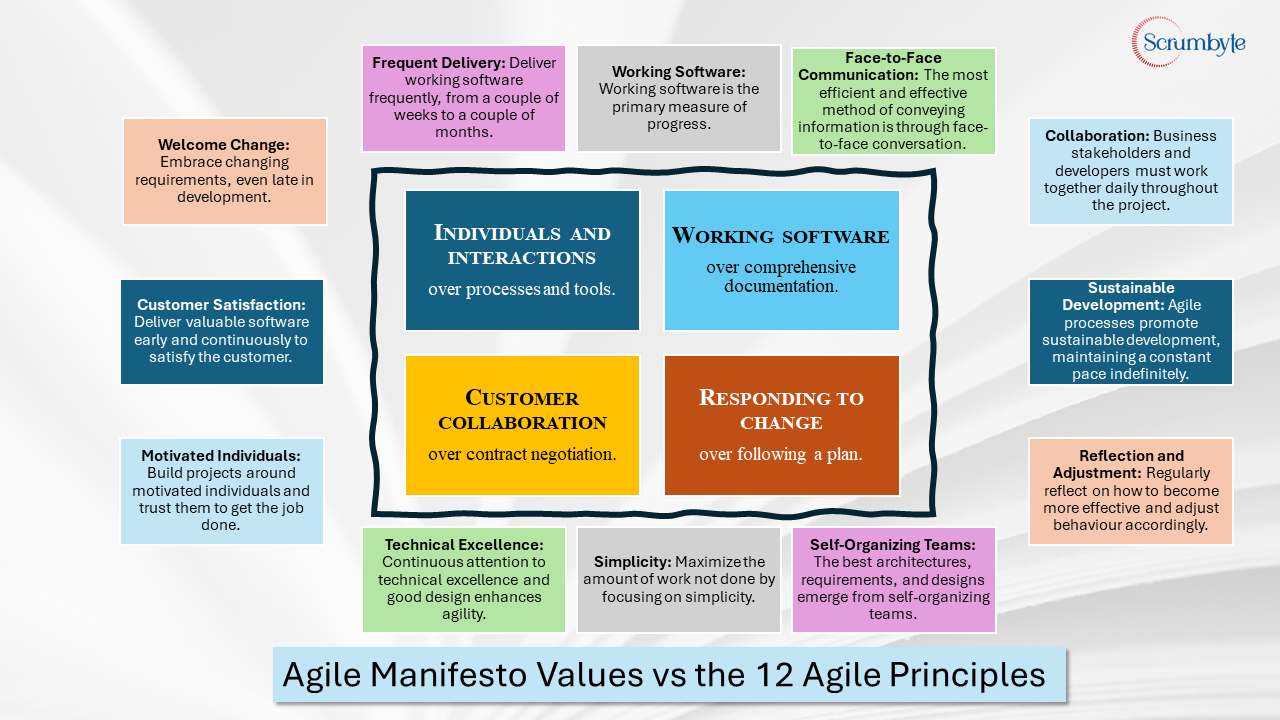
Agile Project Management – A comprehensive guide
What is Agile Project Management?
In today’s fast-paced and ever-evolving business landscape, organizations are continually seeking effective project management methodologies that can adapt to changing requirements and deliver high-quality products efficiently. Agile Project Management has emerged as a popular and highly effective approach, particularly in the fields of software development, IT, and other industries where flexibility and customer satisfaction are paramount. The key here is that Agile Project Management is popularized in IT industry, but is equally effective in other industries as well.
Though most of the viewers of my blog are IT professionals and are interested in Agile, or are practicing it, we need to understand what is Agile Project management?
“Agile Project Management is an iterative and incremental approach to managing projects, emphasizing flexibility, collaboration, customer feedback, and rapid delivery of functional products. Unlike traditional project management methodologies, which often follow a linear and rigid structure, Agile embraces change and promotes continuous improvement throughout the project lifecycle”.
Delving further, here are some of the highlights that are the characteristics of Agile Project Management.
- Iterative Development: Projects are broken down into smaller cycles or iterations, allowing for regular assessment and adaptation.
- Incremental Delivery: Functional components of the project are delivered incrementally, providing value to stakeholders early and often.
- Customer Collaboration: Continuous engagement with customers ensures that the project aligns with their needs and expectations.
- Flexibility: Agile methodologies accommodate changes in requirements, even late in the development process.
- Self-Organizing Teams: Teams are empowered to make decisions and manage their work, fostering creativity and accountability.
For those who are familiar with traditional Project Management here is a comparative table to showcase the differences between the two.
Agile vs. Traditional Project Management
| Aspect | Agile Project Management | Traditional Project Management |
| Approach | Iterative and incremental | Linear and sequential (Waterfall) |
| Flexibility | Highly adaptable to changes | Changes are difficult and costly to implement |
| Customer Involvement | Continuous collaboration and feedback | Limited to initial requirements and final delivery |
| Documentation | Minimal and just-in-time | Comprehensive and extensive |
| Team Structure | Self-organizing and cross-functional teams | Hierarchical and specialized roles |
| Delivery | Frequent, small releases | Single, large release at the end |
As you can see the differences are quite profound and it requires a major shift in your thinking while using and adapting to the Agile.
In the following let us look at all the high level key items that form the agile methodology framework. You can look at the agile project management examples side by side with the traditional project management examples.
Project Structure and Process
Agile: Iterative and Incremental
Agile methodology is highly flexible and follows an iterative and incremental process. Work is divided into small cycles called sprints (typically 2-4 weeks long), and after each sprint, a working product increment is delivered. Agile focuses on adaptation and responding quickly to changes in the project’s scope, requirements, or environment.
- Example: In a software development project, an Agile team may deliver a working prototype at the end of each sprint, gather feedback, and then make adjustments in the next sprint.
Traditional Project Management: Linear and Sequential
Traditional Project Management, or Waterfall, follows a linear and sequential approach. The project is divided into phases (e.g., initiation, planning, execution, monitoring, and closing), and each phase must be completed before the next one begins. Changes to the project are difficult to accommodate once the process is underway.
- Example: In a construction project, a detailed design phase must be completed and approved before the construction work can start, and changes to the design during construction can be costly and disruptive.
Planning and Flexibility
Agile: Adaptive Planning
Agile uses adaptive planning, which means that while there is a broad project roadmap, the specifics of each sprint are planned just before the sprint begins. This allows for changes based on feedback, testing, and new information as the project progresses. Agile embraces uncertainty and continuous learning throughout the project.
- Example: A mobile app development team may prioritize features based on user feedback from a previous sprint, adapting the next sprint plan accordingly.
Traditional Project Management: Rigid Planning
Traditional methods focus on detailed upfront planning. The project scope, timeline, and budget are typically set at the beginning of the project. Changes are managed through a formal change control process, making adjustments to the plan slow and complex.
- Example: In a government infrastructure project, a detailed project plan is created, and any changes to the scope or timeline require approval from multiple stakeholders, often leading to delays.
Stakeholder Involvement
Agile: Continuous Stakeholder Collaboration
In Agile, stakeholders (e.g., customers, users, product owners) are continuously involved throughout the project. Regular feedback is sought at the end of each sprint, ensuring that the product evolves to meet stakeholder expectations and market needs.
- Example: In Agile software projects, customers often attend sprint reviews and provide input that helps shape the next sprint’s objectives.
Traditional Project Management: Limited Stakeholder Engagement
In Traditional Project Management, stakeholder engagement is typically highest during the initiation and planning phases, but it tends to decrease during the execution phase. Stakeholders are only involved again when milestones are achieved or when project deliverables are ready for approval.
- Example: In a manufacturing project, stakeholders may approve the design early on, but may not be involved again until the product is nearly finished.
Project Documentation
Agile: Minimal and Just-in-Time Documentation
Agile prioritizes working software over comprehensive documentation. While documentation is still important, it is kept to a minimum and produced only when necessary. Agile teams prefer to spend time on building the product rather than writing exhaustive documentation.
- Example: In an Agile project, instead of writing a detailed project plan, teams may use user stories in a backlog to define requirements, which are refined as needed during sprints.
Traditional Project Management: Extensive Documentation
Traditional Project Management places a strong emphasis on detailed documentation. Every phase of the project is thoroughly documented, from the initial project charter and scope statement to the final project close-out report.
- Example: In a pharmaceutical project, regulatory compliance requires extensive documentation, including a detailed risk management plan and validation documentation.
Risk Management
Agile: Continuous Risk Identification
Agile methodologies focus on continuous risk management. Risks are addressed incrementally as they arise throughout the sprints. Since Agile projects deliver working products early and frequently, any potential issues or risks are identified and mitigated sooner rather than later.
- Example: In an Agile project to develop a cloud-based solution, potential risks (such as integration issues) are tested and resolved incrementally, reducing the chances of large-scale failures at the end of the project.
Traditional Project Management: Proactive Risk Management
In Traditional Project Management, risk management is proactive and done during the planning phase, with a detailed risk management plan created upfront. While risks are still monitored throughout the project, the initial risk identification process is more thorough at the beginning of the project.
- Example: In an aerospace project, a comprehensive risk register is prepared before project execution, identifying technical, budgetary, and timeline risks and corresponding mitigation strategies.
Success Metrics
Agile: Customer Satisfaction and Product Quality
Agile projects are measured primarily by customer satisfaction and the quality of the deliverables produced at the end of each sprint. Agile emphasizes delivering value to the customer through frequent, high-quality product increments.
- Example: A development team using Agile may measure success based on how well the product meets customer needs, whether new features are working as intended, and whether stakeholders are satisfied with the results.
Traditional Project Management: On-Time, On-Budget Delivery
In Traditional Project Management, success is often measured by whether the project is delivered on time and within budget, as well as adherence to the initial scope. Quality is still important, but the emphasis is on delivering exactly what was planned, when it was promised.
- Example: In a bridge construction project, success would be defined by completing the project by a specified date and within the allocated budget.
The Agile Manifesto
Agile Project Management is guided by the Agile Manifesto, which outlines four fundamental values and twelve supporting principles. These principles prioritize customer satisfaction, adaptability, and team collaboration. A visual representation follows.

Let us look into some details for the above
The 4 Agile Manifesto Values
- Individuals and interactions over processes and tools.
- Working software over comprehensive documentation.
- Customer collaboration over contract negotiation.
- Responding to change over following a plan.
The 12 Principles of Agile Methodology
- Customer Satisfaction: Deliver valuable software early and continuously to satisfy the customer. (Happy customers is the primary goal!)
- Welcome Change: Embrace changing requirements, even late in development. (Varies significantly from traditional Project Management)
- Frequent Delivery: Deliver working software frequently, from a couple of weeks to a couple of months.
- Collaboration: Business stakeholders and developers must work together daily throughout the project.
- Motivated Individuals: Build projects around motivated individuals and trust them to get the job done.
- Face-to-Face Communication: The most efficient and effective method of conveying information is through face-to-face conversation. (No WFH!)
- Working Software: Working software is the primary measure of progress.
- Sustainable Development: Agile processes promote sustainable development, maintaining a constant pace indefinitely.
- Technical Excellence: Continuous attention to technical excellence and good design enhances agility.
- Simplicity: Maximize the amount of work not done by focusing on simplicity.
- Self-Organizing Teams: The best architectures, requirements, and designs emerge from self-organizing teams.
- Reflection and Adjustment: Regularly reflect on how to become more effective and adjust behavior accordingly.
Type of Agile Development Methodologies
Agile Project Management encompasses various frameworks and practices, each with its unique focus and techniques. The most widely adopted Agile methodologies include Scrum, Kanban, Lean, and Extreme Programming (XP). Let us look at some of the various methodologies that can be used along with some simple examples. These list out the agile methodology drawbacks (Limitations!) and also the benefits.
Scrum
Scrum is one of the most popular Agile frameworks, particularly suited for complex projects. It divides the project into fixed-length iterations called sprints, typically lasting 2-4 weeks. Like how a project manager manages traditional project, here the scrum master is the key person who drives the project being the bridge between the development team and the stakeholders.
Key Components of Scrum:
- Roles:
- Product Owner: Defines the product backlog and prioritizes work.
- Scrum Master: Facilitates the Scrum process and removes impediments.
- Development Team: Self-organizing team responsible for delivering the product increment.
- Artifacts:
- Product Backlog: A prioritized list of project requirements.
- Sprint Backlog: A list of tasks to be completed in the current sprint.
- Increment: The sum of all completed product backlog items during a sprint.
- Events:
- Sprint Planning: Defines what will be delivered in the upcoming sprint.
- Daily Stand-Up: Short daily meetings to synchronize activities.
- Sprint Review: Demonstrates the sprint’s outcomes to stakeholders.
- Sprint Retrospective: Reflects on the sprint to improve future sprints.
- Benefits:
- Clear role definitions: Scrum defines responsibilities clearly, which improves team accountability.
- Frequent delivery: With its sprint cycle, Scrum ensures continuous progress and frequent product releases.
- Customer feedback: Continuous customer involvement helps deliver products that closely align with customer expectations.
- Improves transparency: Scrum uses tools like the Scrum board to make the work visible, which improves transparency.
- Limitations:
- Can become complex in larger teams or organizations.
- Strict time-boxing may not be suitable for every project.
Example of Scrum:
A software development team uses Scrum to manage the creation of a new mobile application. They hold sprint planning meetings to decide which features to develop in the next two weeks, conduct daily stand-ups to track progress, review the completed features with stakeholders at the end of the sprint, and hold retrospectives to discuss improvements.
Kanban
Kanban is a visual Agile methodology focused on managing and improving workflow efficiency. It uses a Kanban board to visualize tasks, their status, and workflow stages.
Key Components of Kanban:
- Kanban Board: A visual tool divided into columns representing different workflow stages (e.g., To Do, In Progress, Done).
- Work in Progress (WIP) Limits: Restrictions on the number of tasks in each workflow stage to prevent bottlenecks.
- Continuous Delivery: Emphasizes ongoing delivery without fixed iterations.
Benefits:
- Flexibility: There are no strict sprint deadlines, making it suitable for projects with unpredictable or changing priorities.
- Continuous delivery: Because work is delivered as soon as it is ready, Kanban supports continuous delivery.
- Improved flow: By limiting work in progress, Kanban improves task focus and flow, avoiding bottlenecks.
Limitations:
- Lack of structure: Kanban’s flexibility can lead to a lack of discipline in planning or managing deadlines.
- Not suitable for large projects with many interdependent tasks.
Example:
A marketing team uses Kanban to manage their content creation process. Tasks move across the Kanban board from “Ideas” to “Writing,” “Reviewing,” and “Published,” ensuring that the team maintains a steady flow of content without overloading any stage.
Lean
Lean Agile methodology focuses on maximizing value by eliminating waste and optimizing processes. It emphasizes efficiency, quality, and continuous improvement.
Key Principles of Lean:
- Value: Define value from the customer’s perspective.
- Value Stream: Map out all steps in the process to identify and eliminate waste.
- Flow: Ensure that value flows smoothly through the process.
- Pull: Let customer demand drive the production process.
- Perfection: Continuously seek to improve processes and products.
Benefits:
- Reduces waste: Focuses on delivering what adds value and eliminates unnecessary steps.
- Continuous improvement: Encourages teams to look for ways to improve processes at every stage.
- Increased efficiency: Helps identify bottlenecks and streamline production.
Limitations:
- Hard to implement in teams that are not used to continuous improvement culture.
- May require significant changes in team mindset and workflow.
Example:
A manufacturing company adopts Lean principles to streamline its production line, reducing unnecessary steps, minimizing inventory, and improving product quality by focusing on value-added activities.
Extreme Programming (XP)
Extreme Programming (XP) is an Agile methodology geared towards improving software quality and responsiveness to changing customer requirements. It emphasizes technical excellence and frequent releases.
Key Practices of XP:
- Pair Programming: Two developers work together at one workstation.
- Test-Driven Development (TDD): Writing tests before code to ensure functionality.
- Continuous Integration: Regularly integrating code changes into a shared repository.
- Refactoring: Continuously improving the codebase without changing its functionality.
- Small Releases: Delivering small, frequent updates to the product.
Benefits:
- Focus on technical excellence: XP promotes high code quality through pair programming and continuous integration.
- Faster feedback loop: Regular customer involvement and small releases allow for quick changes.
- Defects are caught early: With TDD, many potential issues are addressed before they become critical.
Limitations:
- Requires discipline: The technical practices of XP (e.g., TDD) require strong commitment from the team.
- Not suitable for all teams: Teams without a focus on engineering practices may struggle with XP.
Example:
A development team uses XP to build a web application, practicing pair programming to enhance code quality, writing unit tests before coding features, and releasing updates every two weeks to incorporate user feedback swiftly.
Let us also look at some of the more popular and followed Agile Methodologies that are practiced.
Crystal
Overview:
Crystal is a family of Agile methodologies (Crystal Clear, Crystal Yellow, etc.) designed with the belief that every project is unique and needs a custom approach. It emphasizes people over processes and adapts based on project size and team.
Example:
A small startup team building a mobile app may use Crystal Clear, a lightweight Agile framework that emphasizes face-to-face communication and frequent delivery of working software.
Benefits:
- Highly adaptable: Crystal can be tailored to fit different project types and sizes.
- Focuses on communication: With its emphasis on people and communication, Crystal can improve team collaboration.
- Scalable: Different Crystal methodologies can be scaled based on the team size.
Limitations:
- Lacks structure: Crystal’s flexibility can lead to inconsistency in larger or more complex projects.
- Less defined roles can lead to confusion in larger teams.
Dynamic Systems Development Method (DSDM)
Overview:
DSDM is a highly structured Agile framework that focuses on project governance and strict prioritization using the MoSCoW technique (Must have, Should have, Could have, and Won’t have). It emphasizes the business value of each feature.
Example:
A financial institution using DSDM to develop a new payment system might prioritize essential security features as “Must Have” using the MoSCoW prioritization method.
Benefits:
- Strong governance: DSDM provides a clear structure for managing projects, making it ideal for high-regulation industries.
- Business-focused: Prioritizes delivering business value over unnecessary features.
- Clear prioritization: The MoSCoW method ensures that essential features are always delivered first.
Limitations:
- More rigid than other Agile frameworks, which can slow down adaptability to change.
- Can be complex for teams unfamiliar with DSDM’s governance processes.
Feature-Driven Development (FDD)
Overview:
FDD is a model-driven Agile methodology that focuses on delivering software in the form of features. Each feature follows a sequence of five basic activities: Develop Overall Model, Build Feature List, Plan by Feature, Design by Feature, and Build by Feature.
Example:
A company developing an e-commerce platform may use FDD to focus on building specific features like product search, customer reviews, and shopping carts.
Benefits:
- Focus on features: FDD’s feature-centric approach ensures that the team delivers customer-visible functionality.
- Scalable: FDD can scale well for large projects with many independent features.
- Predictable timelines: The focus on small, well-defined features makes planning and delivery more predictable.
Limitations:
- Requires experienced teams: FDD relies on strong design and modeling skills.
- Less flexibility in adapting to changing requirements compared to Scrum or Kanban.
Scaled Agile Framework (SAFe) – SAFe Agile
Overview:
SAFe Agile is designed for scaling Agile practices across large enterprises. It builds on Scrum, XP, and Lean, adding layers of coordination between teams. SAFe agile is structured into different levels, from Team, Program, to Portfolio, with specific roles such as Release Train Engineer and Product Manager.
Example:
A multinational tech company implementing SAFe agile to align multiple Scrum teams working on a large cloud infrastructure project.
Benefits:
- Scalable: Provides a structured framework for scaling Agile to large, distributed teams.
- Enterprise-friendly: Adds governance and structure, making it easier for large organizations to adopt Agile.
- Aligned goals: Aligns team-level efforts with overall business goals through clear coordination.
Limitations:
- More complex: SAFe agile adds several layers of complexity, making it harder to implement for smaller teams.
- Can slow down agility by introducing additional processes.
Summary
Agile methodology offers significant advantages over traditional project management by promoting flexibility, continuous feedback, and adaptive planning, making it ideal for dynamic environments like software development. Its iterative approach allows teams to respond to changes more effectively, fostering collaboration and delivering value incrementally. However, Agile’s lack of formal structure can lead to challenges in scope management, especially in large, complex projects where clear documentation and fixed timelines are crucial. While traditional methods provide predictability and comprehensive planning, Agile excels in environments that demand rapid innovation and frequent adjustments. Ultimately, the choice between Agile and traditional project management depends on the project’s specific needs and organizational goals.
Authored by Vijay Chander – All rights reserved 2024 – scrumbyte.com

